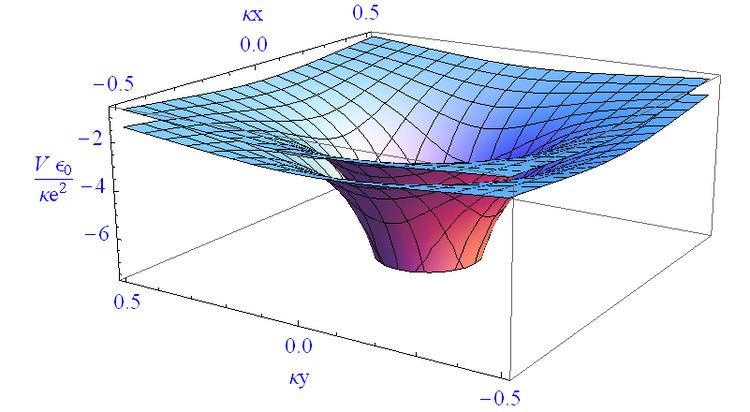 | ||
Lindhard theory is a method of calculating the effects of electric field screening by electrons in a solid. It is based on quantum mechanics (first-order perturbation theory) and the random phase approximation.
Contents
- Formula
- Analysis of the Lindhard formula
- Long wavelength limit
- Static Limit
- One Dimension
- Experiment
- References
Thomas–Fermi screening can be derived as a special case of the more general Lindhard formula. In particular, Thomas–Fermi screening is the limit of the Lindhard formula when the wavevector (the reciprocal of the length-scale of interest) is much smaller than the fermi wavevector, i.e. the long-distance limit.
This article uses cgs-Gaussian units.
Formula
The Lindhard formula for the longitudinal dielectric function is given by
Here,
Analysis of the Lindhard formula
To understanding the Lindhard formula, let's consider some limiting cases in 3 dimensions and 2 dimensions. 1 dimension case is also considered in other way.
Long wavelength limit
First, let's consider the long wavelength limit (
For the denominator of Lindhard formula, we get
and for the numerator of Lindhard formula, we get
Inserting these into Lindhard formula and taking the
where we used
(In SI units, replace the factor
This result is same as the classical dielectric function.
Static Limit
Second, consider the static limit (
Inserting above equalities for denominator and numerator to this, we obtain
Assuming a thermal equilibrium Fermi–Dirac carrier distribution, we get
here, we used
Therefore,
Here,
Then, the 3D statically screened Coulomb potential is given by
And Fourier transformation of this result gives
known as the Yukawa potential. Note that in this Fourier transformation, which is basically a sum over all
For a degenerating gas(T=0), Fermi energy is given by
So the density is
At T=0,
Inserting this to above 3D screening wave number equation, we get
This is 3D Thomas–Fermi screening wave number.
For reference, Debye-Hückel screening describes the nondegenerate limit case.
The result is
Long wavelength limit
First, consider the long wavelength limit (
For denominator of Lindhard formula,
and for numerator of Lindhard formula,
Inserting these to Lindhard formula and taking
where we used
Static Limit
Second, consider the static limit (
Inserting above equalities for denominator and numerator to this, we obtain
Assuming a thermal equilibrium Fermi–Dirac carrier distribution, we get
here, we used
Therefore,
Then, the 2D statically screened Coulomb potential is given by
It is known that the chemical potential of the 2-dimensional Fermi gas is given by
and
So, the 2D screening wave number is
Note that this result is independent of n.
One Dimension
This time, let's consider some generalized case for lowering the dimension. The lower the dimensions is, the weaker the screening effect is. In lower dimension, some of the field lines pass through the barrier material wherein the screening has no effect. For 1-dimensional case, we can guess that the screening effects only on the field lines which are very close to the wire axis.
Experiment
In real experiment, we should also take the 3D bulk screening effect into account even though we deal with 1D case like the single filament. D. Davis applied the Thomas–Fermi screening to an electron gas confined to a filament and a coaxial cylinder. For K2Pt(CN)4Cl0.32·2.6H20, it was found that the potential within the region between the filament and cylinder varies as
